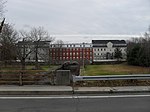E. Brown House
Federal architecture in MassachusettsHouses in Uxbridge, MassachusettsHouses on the National Register of Historic Places in Worcester County, MassachusettsNational Register of Historic Places in Uxbridge, MassachusettsWorcester County, Massachusetts Registered Historic Place stubs

The E. Brown House is an historic house located at 7 Sutton Street, in Uxbridge, Massachusetts. It is a 2+1⁄2-story wood-frame structure, five bays wide, with a side-gable roof, central chimney, and clapboard siding. Despite its otherwise vernacular construction, it has fine quality Federal styling, with corner pilasters and cornice. The cornice and the door surround appear to be carved based on published drawings of Asher Benjamin. The western wing is a 20th-century addition.On October 7, 1983, it was added to the National Register of Historic Places.
Excerpt from the Wikipedia article E. Brown House (License: CC BY-SA 3.0, Authors, Images).E. Brown House
Sutton Street,
Geographical coordinates (GPS) Address Nearby Places Show on map
Geographical coordinates (GPS)
| Latitude | Longitude |
|---|---|
| N 42.09 ° | E -71.65 ° |
Address
Sutton Street 7
01538
Massachusetts, United States
Open on Google Maps










